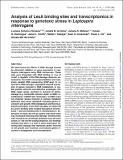| dc.contributor.author | Schons-Fonseca, Luciane | |
| dc.contributor.author | da Silva, Josefa B. | |
| dc.contributor.author | Milanez, Juliana S. | |
| dc.contributor.author | Domingos, Renan H. | |
| dc.contributor.author | Smith, Janet L. | |
| dc.contributor.author | Nakaya, Helder I. | |
| dc.contributor.author | Ho, Paulo L. | |
| dc.contributor.author | da Costa, Renata MA | |
| dc.contributor.author | Grossman, Alan Davis | |
| dc.date.accessioned | 2016-03-11T02:27:26Z | |
| dc.date.available | 2016-03-11T02:27:26Z | |
| dc.date.issued | 2016-02 | |
| dc.date.submitted | 2015-12 | |
| dc.identifier.issn | 0305-1048 | |
| dc.identifier.issn | 1362-4962 | |
| dc.identifier.uri | http://hdl.handle.net/1721.1/101672 | |
| dc.description.abstract | We determined the effects of DNA damage caused by ultraviolet radiation on gene expression in Leptospira interrogans using DNA microarrays. These data were integrated with DNA binding in vivo of LexA1, a regulator of the DNA damage response, assessed by chromatin immunoprecipitation and massively parallel DNA sequencing (ChIP-seq). In response to DNA damage, Leptospira induced expression of genes involved in DNA metabolism, in mobile genetic elements and defective prophages. The DNA repair genes involved in removal of photo-damage (e.g. nucleotide excision repair uvrABC, recombinases recBCD and resolvases ruvABC) were not induced. Genes involved in various metabolic pathways were down regulated, including genes involved in cell growth, RNA metabolism and the tricarboxylic acid cycle. From ChIP-seq data, we observed 24 LexA1 binding sites located throughout chromosome 1 and one binding site in chromosome 2. Expression of many, but not all, genes near those sites was increased following DNA damage. Binding sites were found as far as 550 bp upstream from the start codon, or 1 kb into the coding sequence. Our findings indicate that there is a shift in gene expression following DNA damage that represses genes involved in cell growth and virulence, and induces genes involved in mutagenesis and recombination. | en_US |
| dc.description.sponsorship | Conselho Nacional de Pesquisas (Brazil) | en_US |
| dc.description.sponsorship | Fundacao de Amparo a Pesquisa do Estado de Sao Paulo | en_US |
| dc.description.sponsorship | Fundacao Butantan | en_US |
| dc.description.sponsorship | National Institutes of Health (U.S.) (National Institute of General Medical Sciences (U.S.) Award GM41934) | en_US |
| dc.language.iso | en_US | |
| dc.publisher | Oxford University Press | en_US |
| dc.relation.isversionof | http://dx.doi.org/10.1093/nar/gkv1536 | en_US |
| dc.rights | Creative Commons Attribution | en_US |
| dc.rights.uri | http://creativecommons.org/licenses/by-nc/4.0/ | en_US |
| dc.source | Oxford University Press | en_US |
| dc.title | Analysis of LexA binding sites and transcriptomics in response to genotoxic stress in Leptospira interrogans | en_US |
| dc.type | Article | en_US |
| dc.identifier.citation | Schons-Fonseca, Luciane, Josefa B. da Silva, Juliana S. Milanez, Renan H. Domingos, Janet L. Smith, Helder I. Nakaya, Alan D. Grossman, Paulo L. Ho, and Renata MA da Costa. “Analysis of LexA Binding Sites and Transcriptomics in Response to Genotoxic Stress in Leptospira Interrogans.” Nucleic Acids Research 44, no. 3 (January 13, 2016): 1179–1191. | en_US |
| dc.contributor.department | Massachusetts Institute of Technology. Department of Biology | en_US |
| dc.contributor.mitauthor | Schons-Fonseca, Luciane | en_US |
| dc.contributor.mitauthor | Grossman, Alan D. | en_US |
| dc.relation.journal | Nucleic Acids Research | en_US |
| dc.eprint.version | Final published version | en_US |
| dc.type.uri | http://purl.org/eprint/type/JournalArticle | en_US |
| eprint.status | http://purl.org/eprint/status/PeerReviewed | en_US |
| dspace.orderedauthors | Schons-Fonseca, Luciane; da Silva, Josefa B.; Milanez, Juliana S.; Domingos, Renan H.; Smith, Janet L.; Nakaya, Helder I.; Grossman, Alan D.; Ho, Paulo L.; da Costa, Renata MA | en_US |
| dc.identifier.orcid | https://orcid.org/0000-0001-5718-5366 | |
| dc.identifier.orcid | https://orcid.org/0000-0002-8235-7227 | |
| mit.license | PUBLISHER_CC | en_US |
| mit.metadata.status | Complete | |
